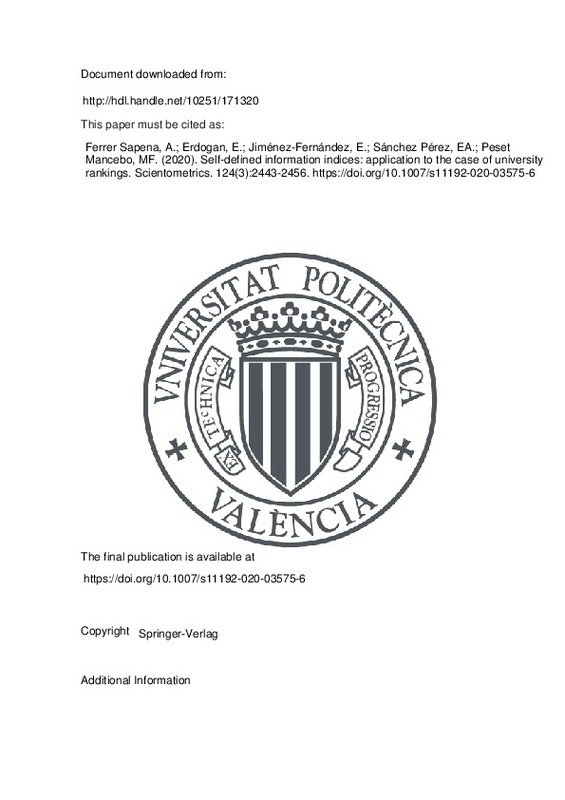Aguillo, I., Bar-Ilan, J., Levene, M., & Ortega, J. (2010). Comparing university rankings. Scientometrics, 85(1), 243–256.
Asadi, K., Dipendra, M., & Littman, M. L. (2018). Lipschitz continuity in model-based reinforcement learning. In Proceedings of the 35th International Conference on Machine Learning, Proc. Mach. Lear. Res., Vol. 80, pp. 264–273.
Bougnol, M. L., & Dulá, J. H. (2013). A mathematical model to optimize decisions to impact multi-attribute rankings. Scientometrics, 95(2), 785–796.
[+]
Aguillo, I., Bar-Ilan, J., Levene, M., & Ortega, J. (2010). Comparing university rankings. Scientometrics, 85(1), 243–256.
Asadi, K., Dipendra, M., & Littman, M. L. (2018). Lipschitz continuity in model-based reinforcement learning. In Proceedings of the 35th International Conference on Machine Learning, Proc. Mach. Lear. Res., Vol. 80, pp. 264–273.
Bougnol, M. L., & Dulá, J. H. (2013). A mathematical model to optimize decisions to impact multi-attribute rankings. Scientometrics, 95(2), 785–796.
Çakır, M. P., Acartürk, C., Alaşehir, O., & Çilingir, C. (2015). A comparative analysis of global and national university ranking systems. Scientometrics, 103(3), 813–848.
Cancino, C. A., Merigó, J. M., & Coronado, F. C. (2017). A bibliometric analysis of leading universities in innovation research. Journal of Innovation & Knowledge, 2(3), 106–124.
Chen, K.-H., & Liao, P.-Y. (2012). A comparative study on world university rankings: A bibliometric survey. Scientometrics, 92(1), 89–103.
Cinzia, D., & Bonaccorsi, A. (2017). Beyond university rankings? Generating new indicators on universities by linking data in open platforms. Journal of the Association for Information Science and Technology, 68(2), 508–529.
Cobzaş, Ş., Miculescu, R., & Nicolae, A. (2019). Lipschitz functions. Berlin: Springer.
Deza, M. M., & Deza, E. (2009). Encyclopedia of distances. Berlin: Springer.
2019 U-Multirank ranking: European universities performing well. https://ec.europa.eu/education/news/u-multirank-publishes-sixth-edition-en .
Dobrota, M., Bulajic, M., Bornmann, L., & Jeremic, V. (2016). A new approach to the QS university ranking using the composite I-distance indicator: Uncertainty and sensitivity analyses. Journal of the Association for Information Science and Technology, 67(1), 200–211.
Falciani, H., Calabuig, J. M., & Sánchez Pérez, E. A. (2020). Dreaming machine learning: Lipschitz extensions for reinforcement learning on financial markets. Neurocomputing, 398, 172–184.
Kehm, B. M. (2014). Global university rankings—Impacts and unintended side effects. European Journal of Education, 49(1), 102–112.
Lim, M. A., & Øerberg, J. W. (2017). Active instruments: On the use of university rankings in developing national systems of higher education. Policy Reviews in Higher Education, 1(1), 91–108.
Luo, F., Sun, A., Erdt, M., Raamkumar, A. S., & Theng, Y. L. (2018). Exploring prestigious citations sourced from top universities in bibliometrics and altmetrics: A case study in the computer science discipline. Scientometrics, 114(1), 1–17.
Marginson, S. (2014). University rankings and social science. European Journal of Education, 49(1), 45–59.
Pagell, R. A. (2014). Bibliometrics and university research rankings demystified for librarians. Library and information sciences (pp. 137–160). Berlin: Springer.
Rao, A. (2015). Algorithms for Lipschitz extensions on graphs. Yale University: ProQuest Dissertations Publishing, 10010433.
Rosa, K. D., Metsis, V., & Athitsos, V. (2012). Boosted ranking models: A unifying framework for ranking predictions. Knowledge and Information Systems, 30(3), 543–568.
Saisana, M., d’Hombres, B., & Saltelli, A. (2011). Rickety numbers: Volatility of university rankings and policy implications. Research Policy, 40(1), 165–177.
Tabassum, A., Hasan, M., Ahmed, S., Tasmin, R., Abdullah, D. M., & Musharrat, T. (2017). University ranking prediction system by analyzing influential global performance indicators. In 2017 9th International Conference on Knowledge and Smart Technology (KST) (pp. 126–131) IEEE.
Van Raan, A. F. J., Van Leeuwen, T. N., & Visser, M. S. (2011). Severe language effect in university rankings: Particularly Germany and France are wronged in citation-based rankings. Scientometrics, 88(2), 495–498.
von Luxburg, U., & Bousquet, O. (2004). Distance-based classification with Lipschitz functions. Journal of Machine Learning Research, 5, 669–695.
[-]







![[Cerrado]](/themes/UPV/images/candado.png)


